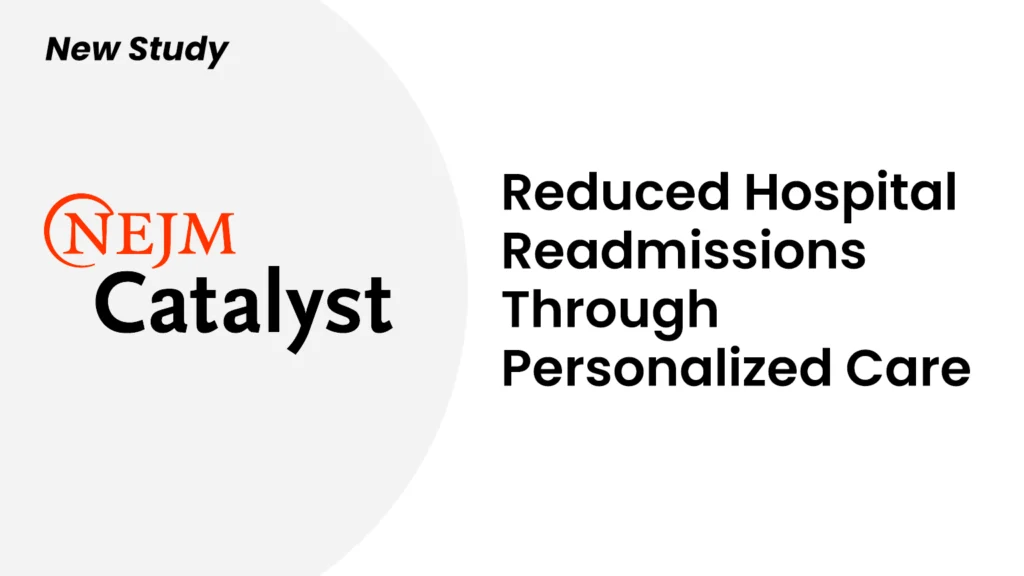Making sure your patients are engaged – one of two key elements driving patient experience – lays the foundation for stronger patient-provider relationships built on trust, empathy, and understanding. Positive relationships can help improve patient satisfaction and yield patient loyalty. And when a patient has a consistent, trusted source of healthcare, health outcomes can improve as well.
The Patient Engagement Playbook
Artera™ recently created “The Patient Engagement Playbook,” which includes six best practices for patient engagement to enable you to foster lasting connections with your patients, ultimately leading to greater results for both your patients and your organization.
Beginning with advice on how and why to establish a digital patient engagement committee, the playbook will walk you through the steps to increase patient engagement.
But first, let’s define what engaged patients are:
- Informed – They understand their health status and the recommended treatment.
- Heard – They communicate with their providers and participate in shared decision-making.
- Empowered – They believe they can change their health outcomes.
- Active – They take action on their health based on personal learnings and overall understanding.
Although engaging patients – and keeping them engaged – can be challenging, it is a vital process for attracting and retaining them. Effectively engaging patients in their care is essential to improving health outcomes and staff efficiency, increasing patient satisfaction, and reducing costs while driving revenue.
“The Patient Engagement Playbook” discusses how greater patient engagement can:
Improve health outcomes: Strong patient engagement increases adherence to treatment regimen recommendations among patients, which in turn leads to fewer complications and re-hospitalizations. Several U.S. studies recently reported coordinated care trials that actively engaged patients with chronic disease resulted in significant mortality reductions compared to a control group who merely took appropriate medications. The studies suggest chronically ill patients who are engaged in their care live longer than unengaged peers who otherwise receive similar treatment, meaning health and well-being are fostered by engaged and activated patients. [1, 2, 3]
Enhance staff efficiency: Patient engagement strategies can help reduce front-end staff workload by reducing time spent on phone calls which take up a significant portion of time and can lead to support staff burnout. With more valuable time back, staff can spend more time on direct patient care.
Increase patient satisfaction: Personalized and unique patient engagement enables patients to feel heard and seen, and empowers them to make decisions about their care. This can enhance overall satisfaction, and facilitate longer-standing relationships with providers while improving patient experience measures.
Reduce cost and drive revenue: Patient engagement directly contributes to outcomes affecting hospital costs and reimbursement for health systems. Executing effective patient engagement strategies also means better patient retention and referrals.
Establish a digital patient engagement committee
The first best practice is to establish a digital patient engagement committee. Why? In today’s digital world, providers must constantly innovate to stay ahead of rapidly changing patient preferences and needs. This largely means investing in some form of technology such as a patient communication platform to enhance the patient experience. At a time when increasing costs, staffing shortages, and supply chain challenges are on the rise, it’s even more critical to prioritize digital solutions that are extremely efficient and will benefit your entire health system by increasing patient satisfaction, reducing costs, and improving staff efficiency, among other benefits.
With so many emerging healthcare technologies and solutions, however, it can be challenging to determine which ones may truly provide the most significant value to your organization and patients alike. Furthermore, trying to coordinate efforts with a variety of different stakeholders across your system can be overwhelming. This is why creating a digital patient engagement committee is important.
This governance committee, or innovation advisory group, can help make strategic decisions for your organization around digital transformation and patient engagement efforts.
Having a centralized patient engagement committee helps to keep multiple digital initiatives in sync and moving forward in lockstep while keeping patients at the forefront. Members of the group work together to:
- Review digital strategy
- Educate teams on initiatives
- Identify and vet new technologies
- Discuss patient feedback
- Facilitate innovative thinking
- Highlight the value and benefits of digital initiatives
To help you establish your own internal patient engagement committee, below are five steps to launching a successful governance group:
Solidify business goals
Before you can build out a successful patient engagement committee, it’s crucial to solidify your organization’s business goals. These will provide a framework for the group to refer back to when making any decisions around digital solutions and patient engagement strategies. By understanding overall business goals, the group will ideally make more strategic decisions around solutions that benefit patients and the organization as a whole.
Questions to consider during this step:
- Can we clearly define business goals?
- How do we ensure our digital investments align with such goals?
Determine internal representatives and group expectations
To ensure unique representation, identify the appropriate stakeholders who will be involved in the patient engagement committee. Think of executives, senior leaders, and physicians who can bring novel perspectives and insights to the discussion – all while advocating for the patients. Make sure to establish roles, responsibilities, and expectations for the group at the start. Working collaboratively, an effective committee will be able to agree on strategy and goals, work together to innovate ideas, and equitably share responsibility.
Patient engagement touches many departments in a health system, so it’s important to determine who will best represent the voice of the patient. Consider the key stakeholders and decision-makers who oversee financial decisions especially if your group will be making decisions about purchasing patient engagement technology. Personnel and departments to consider for the patient engagement committee include the CIO, Patient Experience, Digital Health Experience, among others.
If necessary, consider adding outside advisors to your patient engagement committee. When an advisor comes from outside your organization, they can provide the group with invaluable objectivity. Advisors should not only have the expertise your organization needs but also be able to have an open, honest relationship with the committee to share ideas, offer feedback, and build trust. If there are advisors that can have this type of relationship with your patient engagement committee, they will be able to provide consistent, effective counsel to the group.
Questions to consider during this step:
- Who will be involved in evaluating solutions?
- How do we ensure the patient perspective is taken into account?
- What are the roles and responsibilities of group members?
Outline patient engagement committee goals and objectives
The deployment of efficiency-improving technology should not be incremental — organizations must come up with specific goals and metrics to measure the short, medium, and long-term success of such tools. To ensure accountability, determine how the committee will measure success over time.
When brainstorming and outlining goals, think about the type of challenges you’re trying to solve. Some key issues include no-show rate, call volume, patient satisfaction, and more. Create a list of all the goals and choose from the list of those that are a priority. Determine plans of action and objectives for each goal and set timelines with specific milestones.
Questions to consider during this step:
- What are the top priorities for the patient engagement committee?
- What specific goals are we working towards, and how exactly are we measuring them?
Ensure the digital patient engagement committee measures progress
Utilize any available data and analytics to determine how each solution is working and how it’s impacting the organization as a whole. As a group, review your goals on a regular basis and analyze the metrics previously identified. Uncover any improvements to operational and staff workflows, patient satisfaction, engagement, and more. Identify opportunities for improvement through adjustments or enhancements to certain technologies or solutions. Schedule regular meetings for the patient engagement committee with agenda items to ensure that initiatives progress forward. Keep in mind, the group needs to be flexible and allow objectives to change as new or unforeseen circumstances arise.
Questions to consider during this step:
- Are we hitting our goals?
- Are we using the tools the way we want to be using them?
- Are they consistent with how the vendors offer the software packages?
Listen, learn, iterate
Since a digital patient engagement committee can also help surface the patient voice and feedback from the field, it’s important to dedicate time specifically to this. What are physicians hearing from patients? Are our patients engaged and satisfied? If needed, use patient satisfaction surveys to get customer feedback. These insights can help you iterate on your digital strategy and to drive improvements across the board.
Patient satisfaction surveys are a good way to measure how your patients feel about their experience with your health system. By providing insight into your patients’ perceptions, patient satisfaction surveys can inform your patient engagement committee on which efforts can build meaningful patient/provider relationships. Besides establishing constructive and communication, other advantages to patient satisfaction surveys is to help your providers develop care journeys that are grounded in empathy and based on patient needs.
There are many methods used to conduct surveys, via phone, mail, email, and in-person. They are relatively easy to administer, and compared to other data-collection methods, they can be created in less time. Depending on the survey method, they can be cost-effective. Patient satisfaction surveys can be administered remotely via various methods including questionnaires and in-depth interviews. They can also be conducted through various channels such as online, by text, email, mobile devices, or by telephone. Other important survey questions besides patient satisfaction relationships with staff and provider include the quality of care and access to care and communication.
An important benefit of patient satisfaction surveys is that they can help you start a conversation with your patients and shows your patients that you care about their experience. Use the results of the survey to show patients you are committed to improving their experience by discussing in marketing channels how you are addressing patient concerns.
Patient satisfaction surveys can also help support data-based decision-making, enabling your committee to make informed decisions about how to improve patients’ experiences. This data can also be used to justify to decision makers the investments or changes that the patient engagement committee want to make.
Keep in mind why the group was established in the first place: to identify opportunities, facilitate innovative thinking, vet digital health products, and discuss new ideas. This means if something isn’t working, there’s always an opportunity to grow, improve, and iterate on existing systems.
Questions to consider during this step:
- What’s working for our patients?
- What’s not working?
- What should we consider prioritizing based on patient feedback?
Above all, a sound digital patient engagement committee is always mindful of the patient experience. The goal is to ensure that the solutions, technologies, or initiatives implemented within the health system work for – not against – the patients, clinicians, and staff alike.
Overall, optimized patient engagement strategies are essential for healthcare providers looking to properly address patient needs, which have shifted dramatically as a result of healthcare consumerization and the COVID-19 pandemic. Now more than ever, providers need to consider the six strategies in The Patient Engagement Playbook to facilitate greater patient engagement, connection, and understanding.



